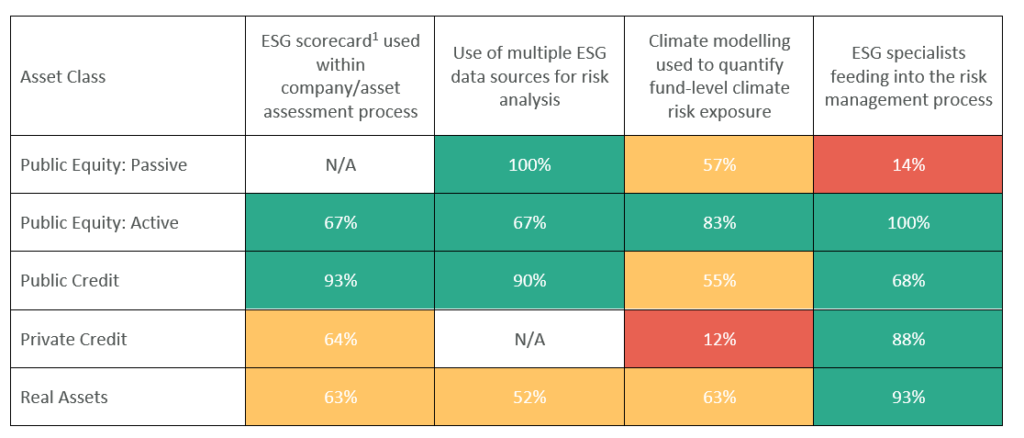All asset managers have an established ESG policy, with around half (c. 50%) of funds covered with ESG objectives in place according to Isio, one of the fastest growing pensions consultancies in the UK. The findings come from Isio’s Sustainable Investment Survey, which evaluated more than 120 funds from across c. 50 asset managers.
Isio assessed the state of ESG integration across various asset classes to provide insights into firm and fund-level practices. It explored positive developments and areas for improvement in asset managers’ ESG commitments, investment approaches, risk management and reporting.
Strong firm-level ESG adoption
Isio found that nearly all (98%) the asset managers it surveyed have a dedicated sustainable investment team supporting ESG risk management and stewardship, while three quarters (75%) have set firm-level net zero commitments. Over two thirds (65%) of firms are signatories to the UK Stewardship Code and a similar proportion (63%) are part of the Net Zero Asset Managers initiative (NZAMI).
Scope for improvement at fund level
Isio found ESG integration is well established among active equity strategies assessed, with four fifths (83%) having fund-level ESG objectives in place. Over two-thirds (67%) of these strategies have fund-level ESG exclusions in place, while another two-thirds (67%) identify ESG-related opportunities at fund-level.
Similarly, Isio found the majority of real assets strategies assessed have set explicit ESG objectives and also offer growing innovative opportunities to access sustainable and impact assets, with their physical nature aligning well to impact investing within such areas as renewable infrastructure, social housing and natural capital. Over four fifths (85%) of real assets strategies assessed identified ESG opportunities at fund-level, with a further three quarters (75%) implementing fund-level ESG objectives, and over half (52%) having fund-level ESG exclusions in place.
ESG integration was noticeably less well established across passive equity and credit sub-asset classes. Just over half (57%) of passive equity strategies have fund-level ESG objectives in place, dropping to under half (43%) of public credit funds and just 12% of private credit strategies, due to challenges with data accessibility.

Robust risk management
Isio analysed different strategies’ integration of ESG factors within risk management frameworks across various asset classes. This comprised analysing internal ESG scorecards, where multiple ESG sources had been used for risk analysis, and the type of climate modelling used to quantify fund-level climate risk exposure.
Assessed strategies performed well across the board. ESG specialists feed into the risk management process for a significant majority of funds assessed, including all active equity strategies, nearly all real assets (93%) and private credit (88%) strategies, and more than two thirds (68%) of public credit strategies.
Isio’s survey uncovered widespread use of ESG scorecards and multiple ESG data sources for asset classes where this is applicable, but room for improvement in climate modelling. While the significant majority of the active equity strategies assessed (83%) use modelling to quantify fund-level climate risk exposure, its use was notably lower among the passive equity (57%), public credit (55%) and private credit (12%) strategies assessed.

Reporting has room for further development
Isio see that only a minority of funds assessed provide TCFD-aligned climate reporting (also capturing scope 3 emissions) particularly in private markets with only 16% of private credit and 11% of real assets able to provide this level of reporting; this is clearly a growing area of focus across the market but still requires further development.
Whilst Isio continue to see a lag in social and nature-related reporting across all asset classes, Isio hope that investors will increasingly engage with such frameworks as the Taskforce on Social Factors (TSF)and the Taskforce on Nature-related Financial Disclosures (TNFD), amongst others to improve reporting moving forward.

Room for growth on sustainable investing
The ability to achieve best practice in sustainable investing varies across asset classes, but collaboration remains an important element of a rounded approach. Asset managers are increasingly engaged with industry initiatives, with over 90% of asset managers assessed signed up to social-related initiatives, such as the Taskforce on Inequality and Social-related Disclosures (TISFD) or the UN Principles for Responsible Investing (PRI) initiative on social issues and human rights. Additionally, asset managers are showing commitment to environmental-related initiatives, such as the Taskforce on Climate-related Financial Disclosures (TCFD) and the Taskforce on Nature-related Financial Disclosures (TNFD).
While Isio expects support for these initiatives to grow, it is encouraging asset managers to engage further with evolving frameworks and standards and continue to raise the bar on sustainable investing in line with market developments and regulations.
Cadi Thomas (She/Her), Head of Sustainable Investment at Isio comments: “Sustainable investing is dynamic and has evolved significantly over recent years, especially when it comes to good practice across different asset classes. At Isio, while we’ve been assessing asset managers for several years, this is our first annual Sustainable Investment Survey, which aims to shine a light on where we see ESG opportunities across asset classes and how investors can seek to ‘green’ their strategies further.
“Real assets strategies in particular offer growing opportunities to access sustainable and impact assets, with the physical nature aligning well to impact investing within areas such as renewable infrastructure, social housing and natural capital. Within credit products, we see significant disparity between sub-asset classes, with ‘buy and hold’ public strategies leading the way, while funds invested in such assets as asset-backed securities, as well as private credit strategies, lagging due to challenges with data accessibility.
“We’ve seen industry-wide improvements in climate-related reporting but continue to see a lag in social and nature-related reporting across all asset classes. It is however encouraging to see investors increasingly engage with environmental and social frameworks, such as the TSF and the TNFD.
We will continue to review asset managers and products on an annual basis so we can raise the bar in line with industry advancements.”





![[uns] house of commons, parliament](https://ifamagazine.com/wp-content/uploads/wordpress-popular-posts/788182-featured-300x200.webp)









